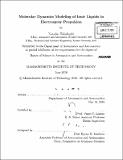Molecular dynamics modeling of ionic liquids in electrospray propulsion
Author(s)
Takahashi, Nanako
DownloadFull printable version (12.35Mb)
Other Contributors
Massachusetts Institute of Technology. Dept. of Aeronautics and Astronautics.
Advisor
Paulo C. Lozano.
Terms of use
Metadata
Show full item recordAbstract
Micro-propulsion has been studied for many years due to its applications in small-to-medium sized spacecraft for precise satellite attitude control. Electrospray thrusters are promising thrusters built upon the state of the art in micro-technology and with flexible performance in terms of their high efficiency and high specific impulse. One challenge is to investigate in detail the mechanism for ion emission to complement experimental results and understand better how emission occurs in the micro to nano scale. Thus, atomistic modeling is used to understand properties of emitted charged particles which determine how the thrusters perform. As a preliminary study of ion emission from Taylor cones, ion evaporation from 3 - 5 nm droplets was observed in molecular dynamics (MD) simulations to validate the atomistic modeling and to investigate activation energies. Ion emission was examined in terms of internal and external electric fields and the activation energies of each case were obtained using Schottky's model and direct energy calculation to compare with experimental values. Ion emission was mainly observed with electric field strengths between 1.2 -2.0 V/nm and the emitted species include both solvated and non-solvated ions. Propulsive properties from Taylor cones are examined using results from the analysis of electric current from ion emission. In addition to an observation of ion emission from liquid droplets, numerical simulations for interactions between a solid plate and liquid droplets were conducted with MD simulation. It was concluded that another selection of force field needs to be considered to pursue further details, such as electrochemical effects.
Description
Thesis (S.M.)--Massachusetts Institute of Technology, Dept. of Aeronautics and Astronautics, 2010. Cataloged from PDF version of thesis. Includes bibliographical references (p. 119-124).
Date issued
2010Department
Massachusetts Institute of Technology. Department of Aeronautics and AstronauticsPublisher
Massachusetts Institute of Technology
Keywords
Aeronautics and Astronautics.